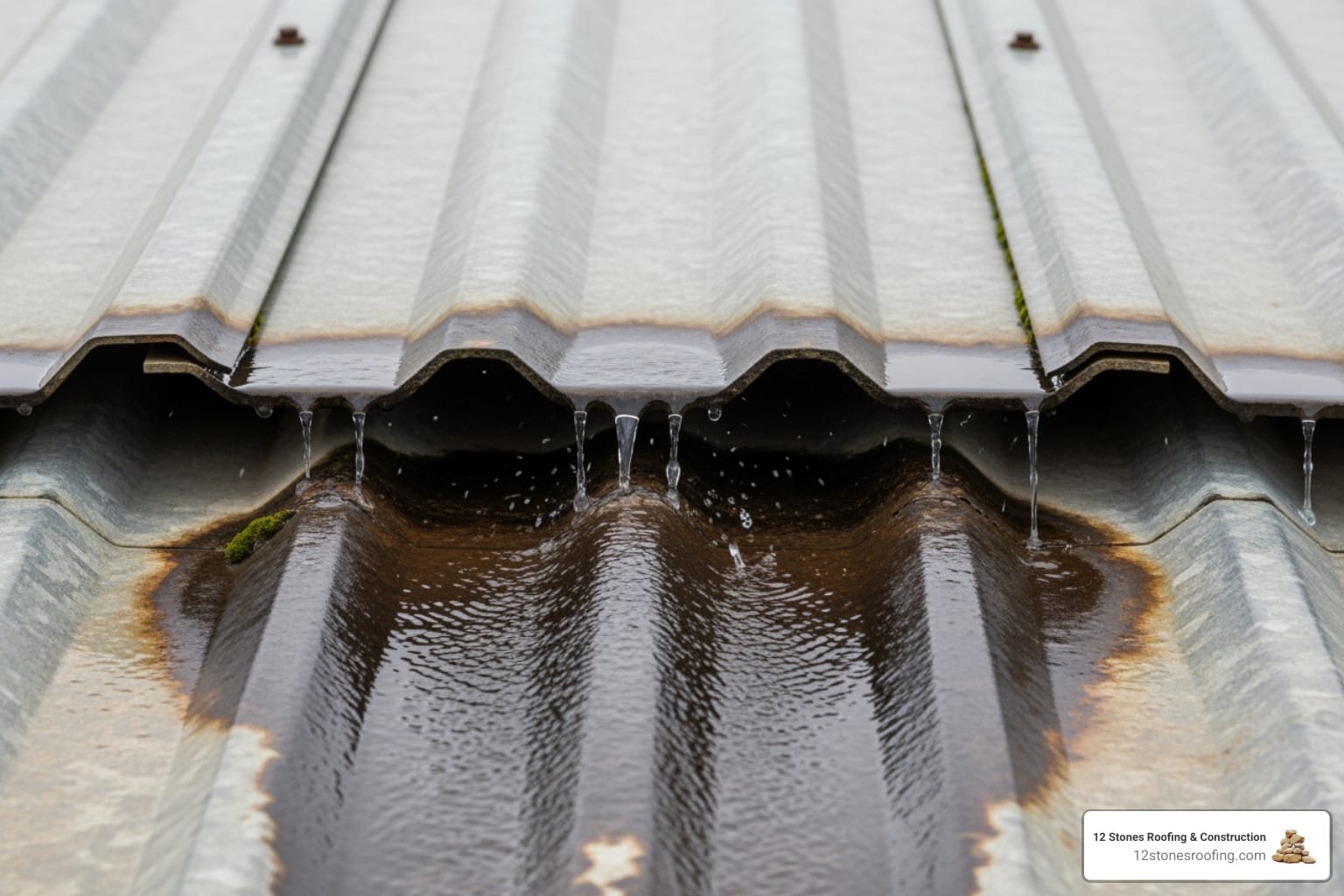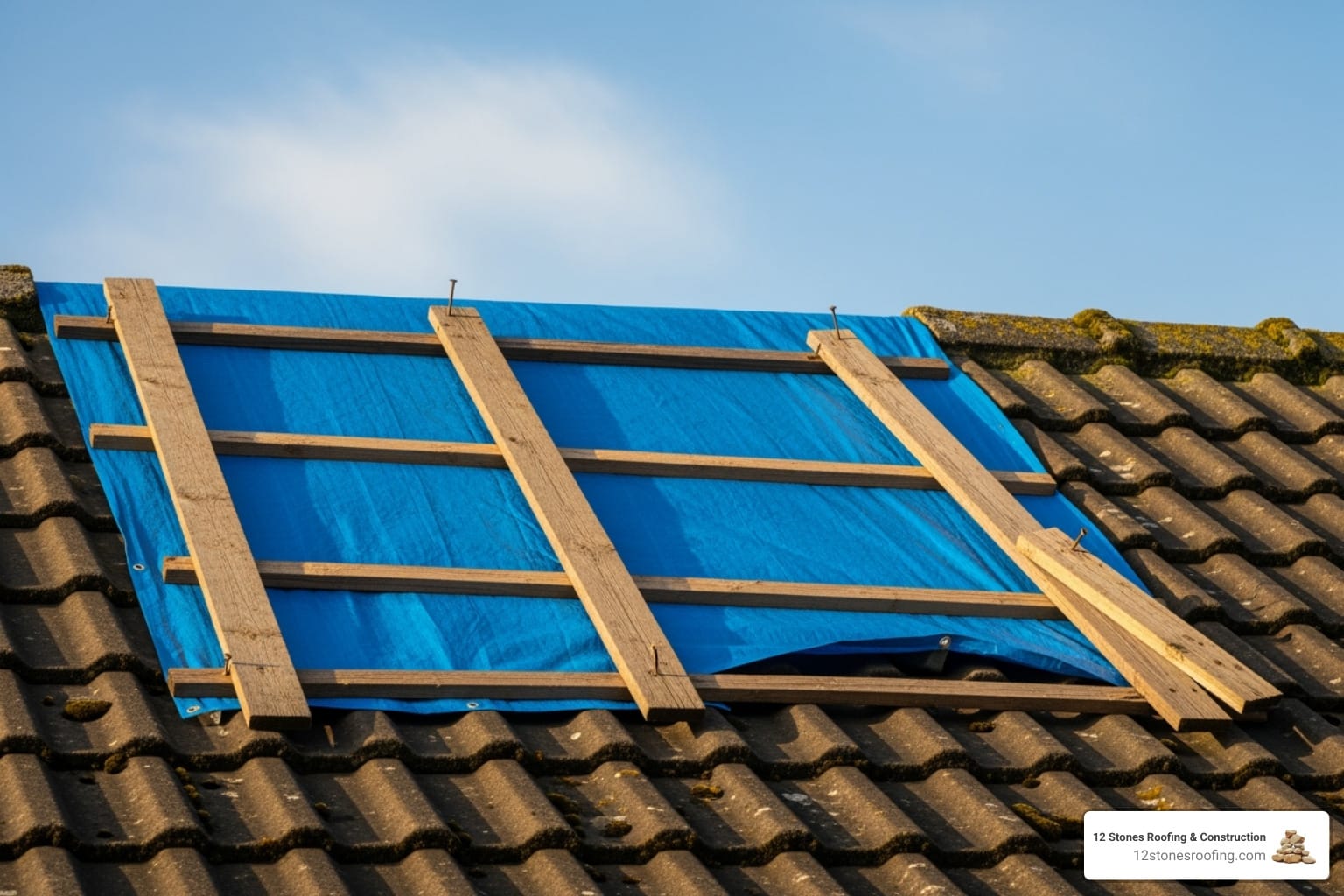Is a Metal Roof-Over Right for Your Home?
The best way to put metal roof over shingles involves installing a quality synthetic underlayment followed by horizontal battens (furring strips). This method creates essential ventilation and a level surface for your new metal panels, forming a durable, long-lasting system. For Texas homeowners, the resilience of metal roofing against severe weather is a critical advantage.
Essential Steps for Installing Metal Over Shingles:
- Verify compliance – Check local codes permit a roof-over.
- Inspect thoroughly – Ensure the deck is solid and shingles are flat.
- Install underlayment – Lay a synthetic barrier over existing shingles.
- Add battens – Secure furring strips for ventilation and a level plane.
- Install panels – Attach metal roofing with proper fasteners.
- Add flashing – Seal all edges, valleys, and penetrations.
This method can save up to 25% in labor costs and creates a roof that lasts 40-70 years—two to three times longer than asphalt. You also reduce landfill waste and can improve your home’s energy efficiency. However, this approach isn’t for every roof. If your existing shingles are curling, damaged, or you have multiple layers, a full tear-off is necessary. Covering hidden moisture or a compromised deck will lead to costly future repairs.
I’m Jason Roberts, owner of 12 Stones Roofing & Construction in Pasadena, Texas. With over a decade of experience on the Gulf Coast, I know that proper preparation and ventilation are what make a metal roof last a lifetime.
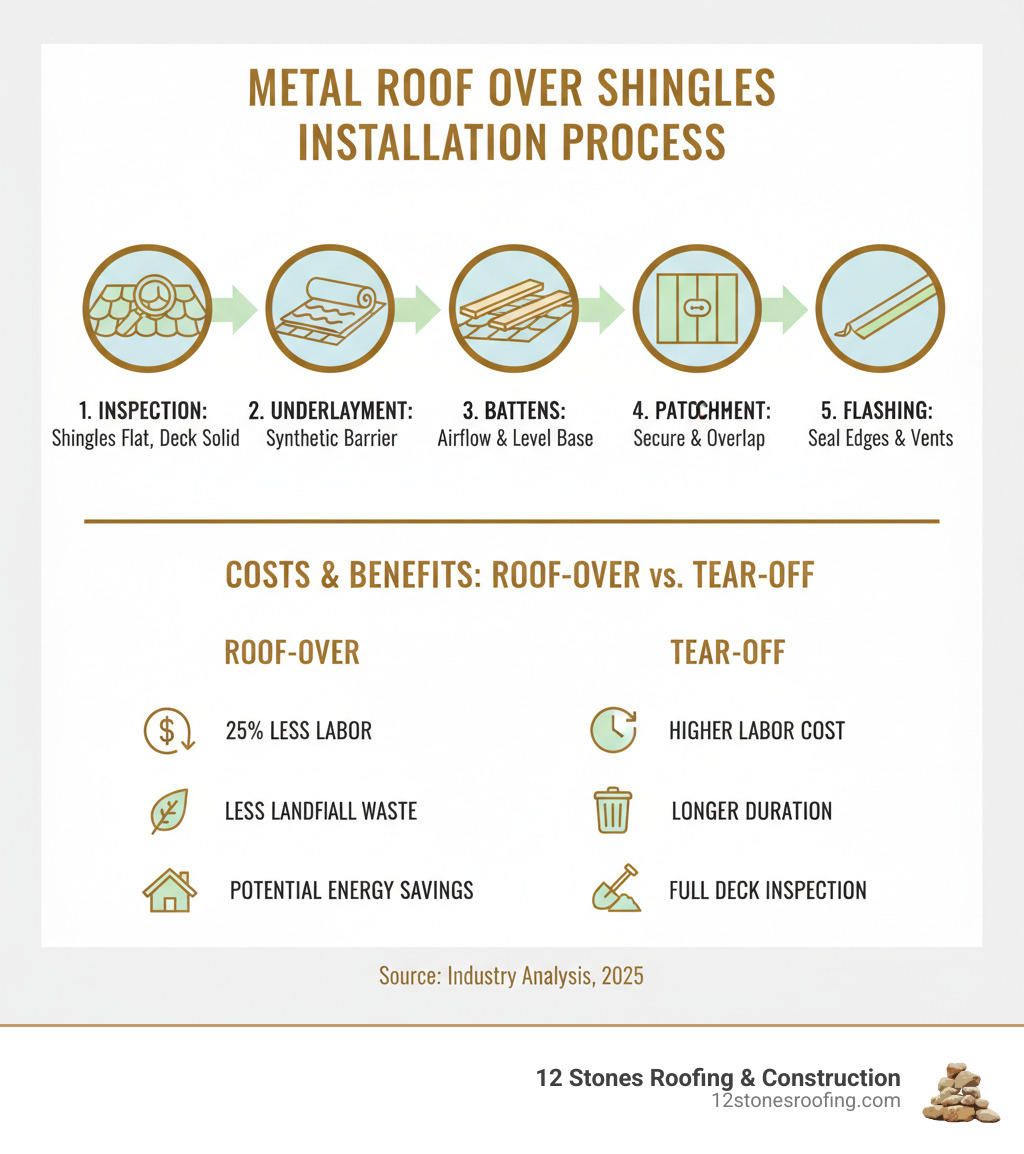
Why a Roof-Over? The Top 3 Advantages of Covering Shingles with Metal
When facing a roof replacement, deciding between a full tear-off and a metal roof-over can be tough. While a tear-off provides a fresh start, the best way to put metal roof over shingles offers compelling advantages. If your existing shingles and roof structure are sound, a metal roof-over saves money, time, and hassle while delivering the exceptional durability of metal roofing.
Cost-Effectiveness: Saving Up to 25% on Your New Roof
The most significant advantage is cost savings. By skipping the tear-off, you eliminate labor-intensive work and expensive disposal fees. You can save up to 25% on labor costs by leaving the existing shingles in place. A traditional tear-off involves days of labor, dumpster rentals, and landfill charges—all of which are avoided with a roof-over.
While metal roofing has a higher upfront cost than asphalt ($7 to $20 per square foot vs. a lower initial price for asphalt), its longevity makes it a smart investment. A metal roof lasts 40 to 70 years, compared to 12 to 20 for asphalt. This long-term value, combined with the initial labor savings of a roof-over, makes it a financially sound choice.
| Feature | Metal Roof-Over (Over Shingles) | Full Tear-Off (New Metal) | Full Tear-Off (New Asphalt Shingles) |
|---|---|---|---|
| Initial Cost | Moderate to High (Lower than new metal tear-off) | High | Low to Moderate |
| Labor Costs | Reduced (no tear-off, no disposal) – up to 25% savings | Standard (includes tear-off and disposal) | Standard (includes tear-off and disposal) |
| Disposal Fees | Eliminated | Included | Included |
| Underlying Deck Insp. | Limited (unless battens are used) | Full | Full |
| Lifespan | 40-70 years | 40-70 years | 12-20 years |
| Energy Savings | Up to 40% (with reflective properties and ventilation) | Up to 40% (with reflective properties and ventilation) | Minimal |
| Environmental Impact | Reduced landfill waste | Landfill waste from old roof | Landfill waste from old roof |
| Average 2,000 sq ft | ~$13,000 – $16,000 (estimate, saving 25% on labor vs. new metal) | ~$17,500 – $40,000 (steel) | ~$8,926 |
Best Durability and Longevity
Metal roofing is exceptionally durable. When properly installed over shingles using the batten method, a metal roof lasts two to three times longer than asphalt shingles. You can expect 40 to 70 years of reliable protection, meaning you install it once and don’t have to worry about it for decades.
Metal also stands up to severe weather. Here in Texas, we face hurricane-force winds, hailstorms, and intense summer heat. High-quality metal roofs are warranted for winds up to 120 miles per hour. Stone-coated metal roofs can resist damage from hail up to 2.5 inches in diameter. Unlike asphalt shingles that crack, curl, and lose granules, metal panels maintain their integrity with virtually no maintenance.
Improved Energy Efficiency
Imagine cutting your summer cooling costs by up to 40%. Metal roofing makes this possible by reflecting sunlight instead of absorbing it, unlike dark asphalt shingles that trap heat and turn your attic into an oven. This reflective quality is a key component of “Cool Roof” technology.
When shopping for metal roofing, look for products with a high Solar Reflective Index (SRI) of 29 or higher in the Cool Roof Rating Council’s database. The higher the SRI, the cooler your roof will stay. The best way to put metal roof over shingles using battens improves this effect by creating an air gap for Above Sheathing Ventilation (ASV). This channel allows hot air to escape, reducing attic temperatures and preventing heat from entering your home. This ventilation also prevents condensation, protecting your roof deck from moisture damage.
By leaving existing shingles, you also keep tons of waste out of landfills, making it a greener option for your home without sacrificing performance.
Before You Begin: 4 Critical Pre-Installation Checks
Before installing a metal roof over existing shingles, a thorough assessment is non-negotiable. Skipping these checks can lead to significant problems down the line. The integrity of your new roof depends entirely on the condition of the structure beneath it.
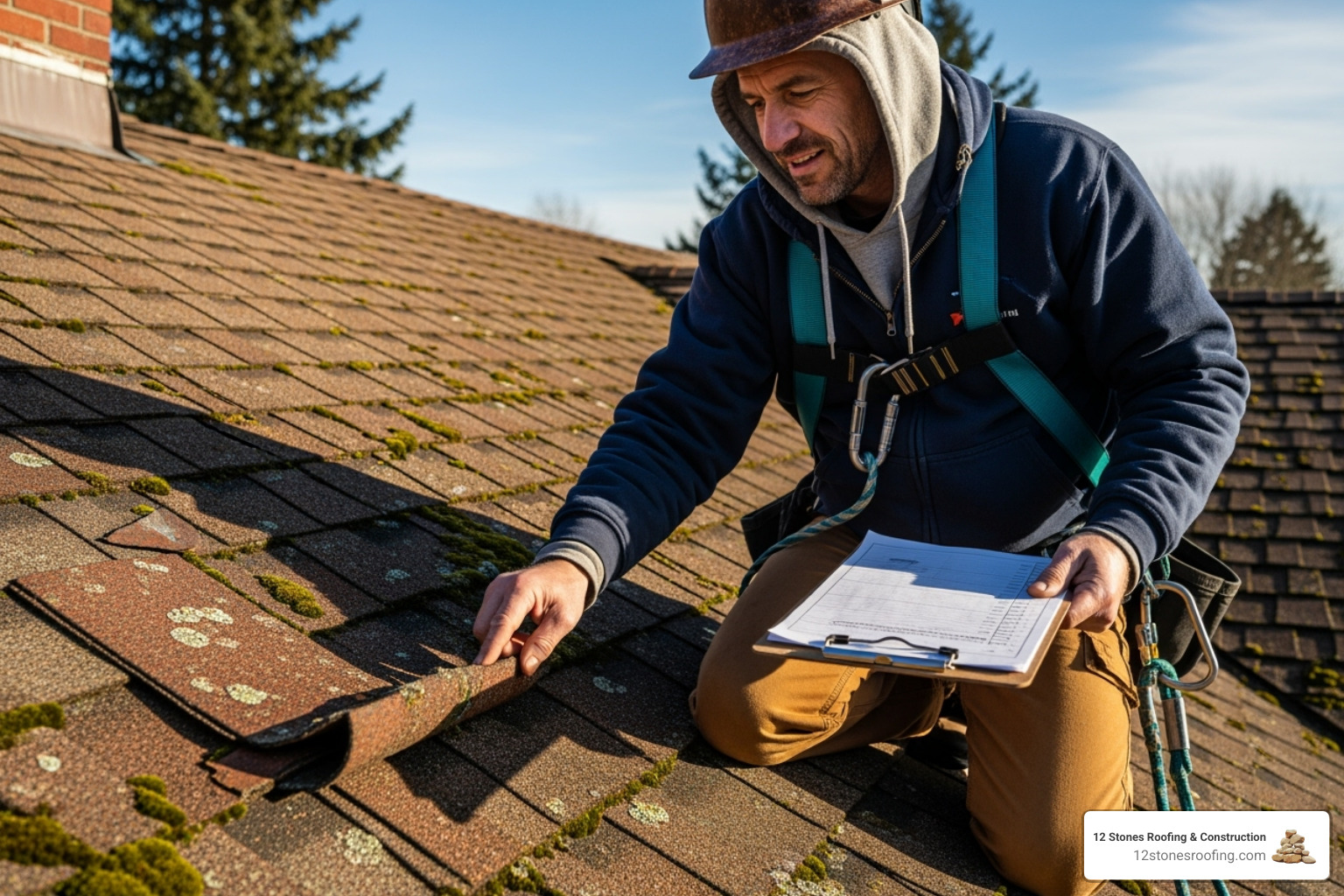
Here are the four critical pre-installation checks we perform:
1. Verify Local Building Codes
First, we verify local building codes. Regulations vary, and while most municipalities permit a metal roof over a single layer of shingles, some have restrictions. For instance, if your home already has two layers of shingles, a roof-over is typically not allowed, and a full tear-off is mandatory. Ensuring compliance with local codes is essential to avoid fines and future issues when selling your home.
2. Assess the Existing Shingle Roof
The condition of your existing asphalt roof is the most crucial factor. A detailed roof inspection is needed to confirm it’s a suitable candidate.
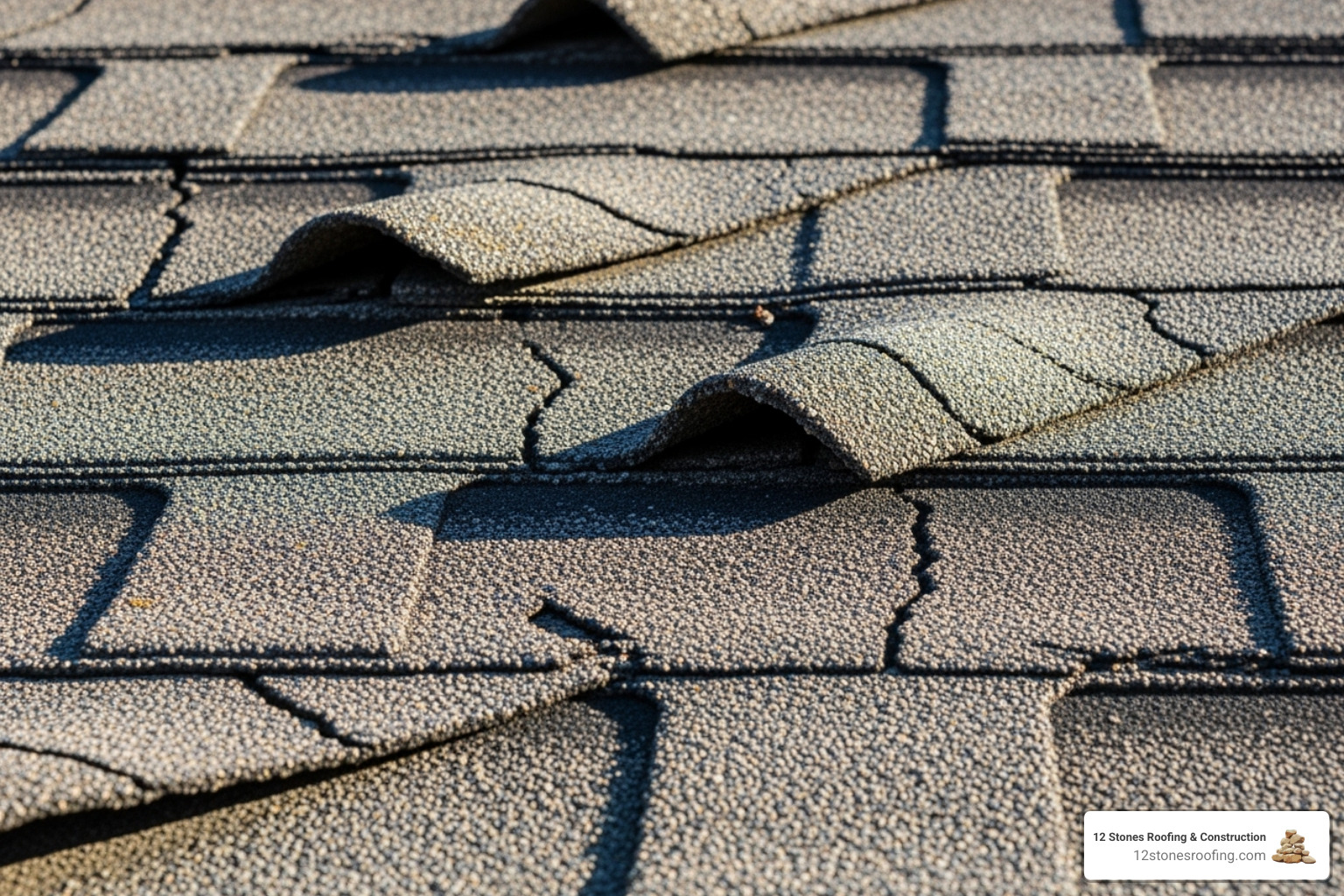
- Single Layer Only: There should only be one layer of asphalt shingles to avoid excessive weight.
- No Curling or Cupped Shingles: The shingles must lie flat. Curled or warped shingles will create an uneven surface under the new metal.
- No Widespread Granule Loss: Significant granule loss indicates the shingles are at the end of their life.
- No Soft or Spongy Spots: Any soft spots indicate moisture damage or rot in the roof deck, which must be repaired.
If the shingles are in poor condition, a roof-over is not recommended. Covering up problems only leads to more expensive repairs later.
3. Inspect the Roof Deck for Damage
Because a roof-over prevents a direct inspection of the underlying roof deck (usually plywood or OSB), check for any signs of weakness from below (in the attic) or by walking the roof. If the deck is compromised by rot or water damage, it cannot support a new roof. Covering a damaged deck is a recipe for structural failure. In such cases, a full roof replacement is the only safe option.
4. Confirm Structural Weight Capacity
Adding a new roof layer increases the load on your home’s structure. While metal roofing is light (0.5 to 1.5 lbs/sq ft), it’s being added on top of existing shingles (2 to 4 lbs/sq ft). For older homes, a structural engineer’s assessment may be needed to confirm the frame can handle the combined weight. This step is critical for your home’s long-term structural integrity.
The Best Way to Put a Metal Roof Over Shingles: A Step-by-Step Guide
Once pre-installation checks are complete, we begin the meticulous installation process. Safety and precision are paramount to ensure your new roof performs for decades.
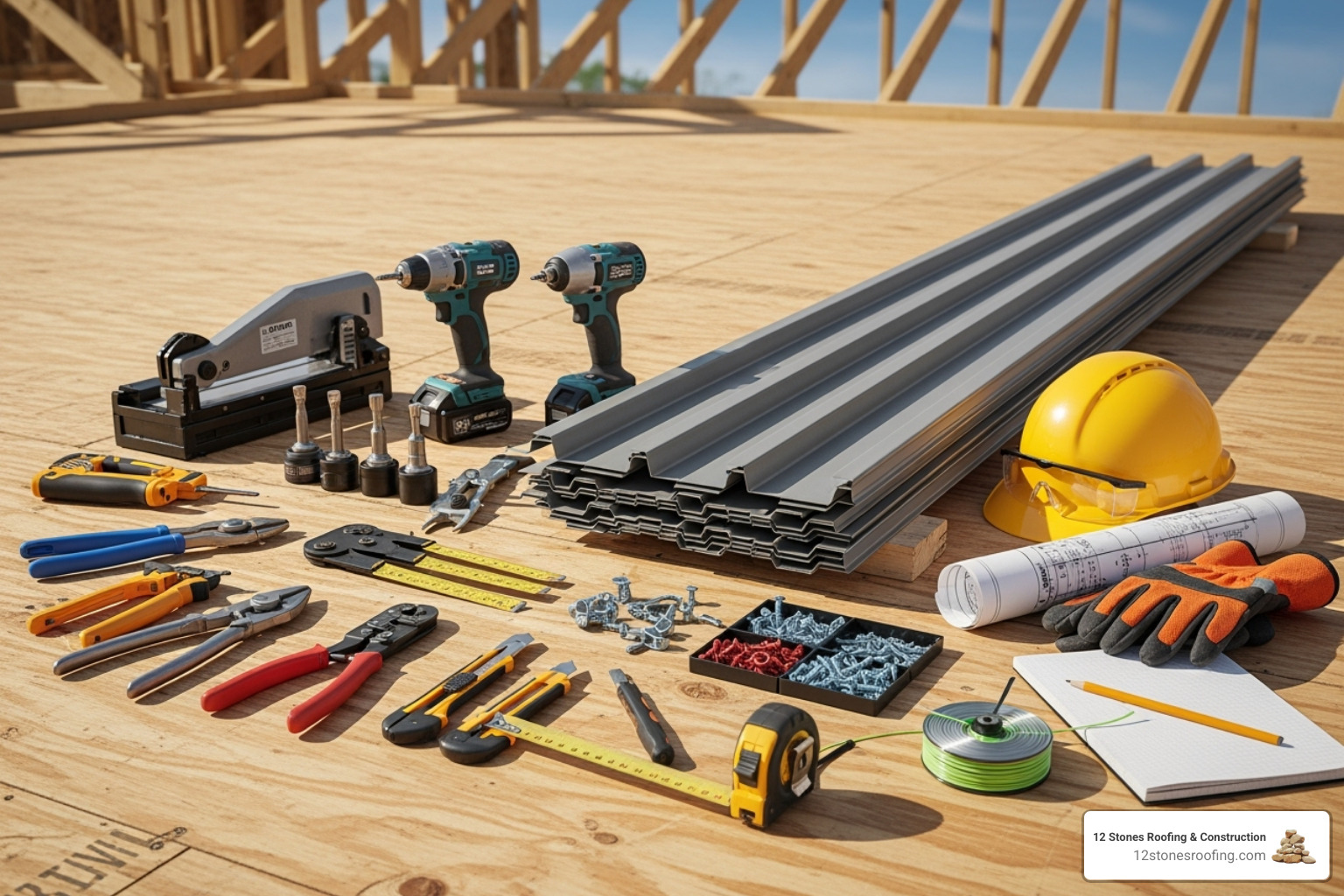
Here’s our step-by-step guide to the best way to put metal roof over shingles:
Step 1: Prepare the Roof and Install Underlayment
First, we prepare the existing roof. This involves cleaning the shingle surface of all debris and removing any existing vents, roof jacks, and edge trim. A clean, smooth surface is essential for a quality installation.
Next, we install a high-quality synthetic underlayment directly over the shingles. This is a critical step that should never be skipped. The underlayment serves three key functions:
- Moisture Barrier: It provides a secondary layer of protection against water intrusion.
- Abrasion Prevention: It protects the back of the metal panels from the rough shingle surface as the metal expands and contracts with temperature changes.
- Smooth Surface: It helps prevent minor imperfections in the old roof from showing through the new metal, a phenomenon known as “oil canning.”
Step 2: The Best Way to Put Metal Roof Over Shingles Using Battens
This step is what separates a standard roof-over from a high-performance system. We install 1×4 or 2×4 wood battens (furring strips) horizontally across the roof, spaced about 24 inches apart. These battens are fastened securely through the shingles and into the roof trusses.
This batten system provides several crucial benefits:
- A Level Plane: It smooths out any irregularities in the old shingle surface, creating a perfectly flat base for the new metal panels.
- Ventilation Air Gap: The space created between the old and new roof allows for “Above Sheathing Ventilation” (ASV). This air channel lets hot air escape, significantly reducing heat transfer into your attic and lowering cooling costs. It also reduces condensation risk, preventing mold and rot.
- Superior Wind Resistance: By anchoring directly to the trusses, the battens provide exceptional wind uplift resistance, a vital feature for homes on the Gulf Coast.
Note: If pressure-treated lumber is used for battens, a protective barrier is installed between the wood and metal to prevent corrosion.
Step 3: Install the Metal Panels and Flashing
With the foundation set, we install the metal panels. We begin at the eave, ensuring the first panel is perfectly straight. Subsequent panels are overlapped according to manufacturer specifications to create a watertight seal. We use corrosion-resistant roofing screws with rubber gaskets to secure the panels to the battens.
Panels are carefully measured and cut to fit around vents, chimneys, and skylights. Proper flashing is then installed to seal these vulnerable areas. Eave trim, valley flashing, rake trim, and ridge caps are carefully installed and sealed to prevent any water intrusion. This detailed finishing work is what guarantees a watertight, high-performance roof that will last for decades. For more technical details, you can review this white paper from the Metal Construction Association.
Potential Risks and How to Avoid Them
While a metal roof-over offers many benefits, it’s important to understand the potential risks. Knowing how to avoid these pitfalls is key to a successful, long-lasting roof.
Managing Moisture and Ensuring Proper Ventilation
Trapped moisture is the biggest concern with a roof-over. If water gets between the shingle and metal layers, it can cause mold, rot in the roof deck, and compromise the entire structure. Improper ventilation can also lead to heat buildup in the summer and condensation in the winter.
How to Avoid It: Our batten system is the primary defense. The air gap it creates allows for Above Sheathing Ventilation (ASV), enabling air to circulate freely, dry out any incidental moisture, and regulate temperature. We also ensure proper ridge and soffit vents are integrated to create a complete ventilation system, which is essential in the humid Texas climate.
Understanding Weight and Structural Impact
Placing a new roof over an old one adds weight to your home’s structure. A metal roof (0.5-1.5 lbs/sq ft) on top of asphalt shingles (2-4 lbs/sq ft) creates a combined load of 2.5 to 5.5 lbs/sq ft. Your home’s frame must be able to support this additional weight safely for decades.
How to Avoid It: Our pre-installation check includes a thorough assessment of your roof’s structural capacity. For older homes or those with potential vulnerabilities, we may recommend a structural engineer’s evaluation to confirm the frame can handle the load. We never take chances with your home’s structural integrity.
Navigating Your Roofing Warranty
Metal roofing manufacturers have specific installation requirements. Failure to follow them, especially in a complex roof-over application, can void your warranty. This leaves you without protection if a product defect occurs.
How to Avoid It: We are meticulous about following all manufacturer guidelines for the specific roofing system being installed. This includes using the correct fasteners, underlayment, and adhering to all rules for installing over existing shingles. We also provide our own workmanship warranty, guaranteeing our installation meets the highest standards. We ensure you understand all warranty implications before work begins.
Frequently Asked Questions about Installing Metal Over Shingles
We hear a lot of great questions from homeowners considering a metal roof-over. Here are some of the most common ones, answered directly:
What is the best way to put a metal roof over shingles?
The best way to put metal roof over shingles is to install a high-quality synthetic underlayment directly over the existing shingles, followed by a batten (furring strip) system. This method involves securing 1×4 or 2×4 wood battens horizontally across the roof, creating a level surface and, crucially, an air gap. This air gap is vital for ventilation, preventing moisture buildup and heat transfer, and allowing the metal panels to expand and contract naturally. This approach ensures optimal performance, longevity, and energy efficiency for your new metal roof.
How long does a metal roof over shingles last?
When installed correctly over a suitable single layer of shingles, a metal roof can last an impressive 40 to 70 years. This lifespan is significantly longer than traditional asphalt shingles, which typically last 12 to 20 years. The longevity of your metal roof-over is dependent on several factors, including the quality of the installation, proper ventilation, the condition of the underlying structure, and the type of metal chosen. With proper care and our expert installation, you can expect decades of reliable protection.
Will installing a metal roof over shingles make my house noisy in the rain?
No, this is a common misconception, and we’re happy to debunk it! When installed over existing shingles with a proper underlayment and/or a batten system, a metal roof is generally no louder than a standard asphalt roof. The multiple layers—your existing shingles, the underlayment, the air gap created by the battens, and the new metal panels—all work together to provide significant sound-dampening insulation. In fact, many homeowners find the soft patter of rain on a well-installed metal roof to be quite soothing, especially compared to the harsher sounds some expect.
Get a Lasting, High-Performance Roof Today
A properly installed metal roof-over is a smart investment in your home’s future. It delivers exceptional durability, improved energy efficiency, and significant long-term value. The best way to put metal roof over shingles is about creating a system that will protect your family and your investment for the next 40 to 70 years—potentially the last roof your home will ever need.
For homeowners in Pasadena, TX, and across the Gulf Coast, local expertise is crucial. Our weather demands a roof built to withstand hurricane-force winds, intense heat, and hailstorms. At 12 Stones Roofing & Construction, we have over a decade of experience perfecting metal roof installations in this challenging climate.
Your roof is too important for guesswork. The difference between a 50-year roof and one that fails early lies in the details: proper ventilation, structural assessment, and expert installation. Ready to see if a metal roof-over is right for your home? We provide honest, thorough assessments to help you make an informed decision.
Find more about our comprehensive Metal Roofing solutions or contact us for a professional consultation. We’re here to deliver a roof that protects your home for generations.



